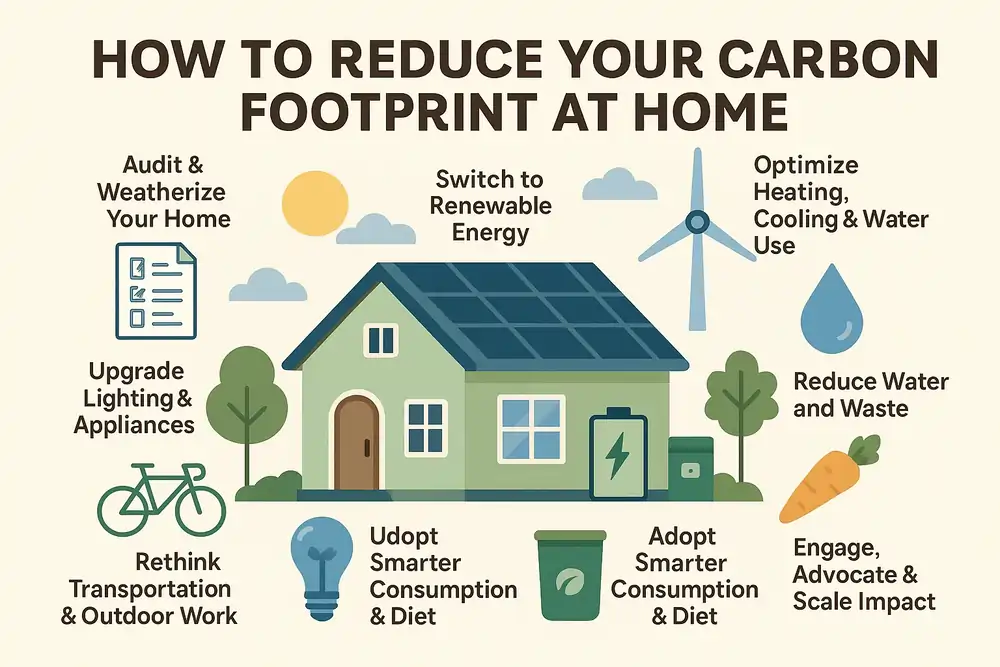Reducing your carbon footprint doesn’t have to mean growing your own food and living by candlelight. Small, intentional actions at home can make a huge impact—on the planet and your energy bills.
Whether you’re new to the green living game or looking to level up, this guide walks you through realistic, effective ways to slash your emissions at home—without breaking the bank.
🏡 Step 1: Start With a Home Energy Audit
Think of this as your sustainability health check.
- DIY: Use free online tools to identify energy suckers.
- Pro option: Many utility companies offer free or discounted audits.
- What it finds: Drafty windows, poor insulation, leaky ducts, outdated appliances.
🛠️ Quick fix: Seal windows and doors with weather stripping or caulk. Insulate your attic—it’s often the biggest heat escape route.
🌡️ Step 2: Heat & Cool Smarter
Heating and cooling make up nearly half of your energy bill. Here’s how to tame them:
- Install a smart thermostat and program it to adjust when you’re asleep or out.
- Drop your temp in winter by 2–5°F, raise it in summer.
- Switch to a heat pump—these efficient systems can cut your emissions by up to 60%.
💡 Bonus tip: Set your water heater to 120°F and wrap it in an insulating blanket to avoid wasting energy.
🔌 Step 3: Make the Switch to Clean Energy
If you’re still relying on fossil fuels for electricity, it’s time for a change.
- Install rooftop solar panels if feasible—there are often rebates!
- Buy into a renewable energy plan through your utility.
- Use smart plugs to run appliances during off-peak (lower-carbon) hours.
☀️ Even small changes help. Running your dishwasher at night can lower your grid impact.
💡 Step 4: Upgrade Your Lighting & Appliances
One of the easiest wins.
- Switch to LED bulbs—they last longer and use up to 85% less energy.
- Unplug vampire devices (like TVs and chargers) or use smart power strips.
- Go ENERGY STAR when replacing appliances.
🔄 No need to replace everything at once. Start with the next thing that breaks.
🚿 Step 5: Cut Water Waste (and Hot Water Emissions)
Water itself isn’t the carbon villain—but heating it is.
- Install low-flow showerheads and faucets.
- Only run full loads in your dishwasher and washing machine.
- Fix leaks—especially hot water ones!
🚰 Each drip adds up. A leaky hot tap can waste hundreds of gallons per year.
🥕 Step 6: Reimagine Your Kitchen Habits
Food has a surprisingly large footprint. Here’s how to shrink it:
- Eat more plants, less meat—especially beef and lamb.
- Compost your scraps instead of tossing them.
- Buy local and seasonal to avoid long transport emissions.
🥗 Not ready to go full vegan? Even 1–2 plant-based meals per week makes a difference.
🛒 Step 7: Shop Less, Live More
Before clicking “Buy Now,” ask yourself: Do I need this?
- Choose quality over quantity—especially in clothing and electronics.
- Repair before replacing.
- Embrace second-hand treasures—furniture, fashion, tools, you name it.
🧵 Fast fashion is a fast track to climate damage. Thrift shops are your eco-friendly playground.
🚲 Step 8: Rethink Transportation (Even While Staying Home)
Even working from home doesn’t mean your carbon footprint disappears.
- Use electric tools (like lawn mowers or leaf blowers) instead of gas-powered ones.
- Walk or bike short trips instead of driving.
- If driving, consider switching to an EV when it’s time for a new car.
✈️ Bonus tip: Skipping just one round-trip flight per year can save hundreds of pounds of CO₂.
💬 Step 9: Use Your Voice & Your Vote
Your actions matter—but your influence is even bigger.
- Talk to friends and family about sustainable choices.
- Support companies that are committed to carbon neutrality.
- Vote for leaders who prioritize climate policies.
🌍 Individual action + collective effort = real change.
📊 Quick Win Summary
| Action | Impact |
|---|---|
| LED lightbulbs | Up to 4,000 lbs CO₂/year |
| Adjusting thermostat | 1,000–2,000 lbs CO₂/year |
| Composting & reducing food waste | 300–500 lbs CO₂/year |
| Eating more plant-based meals | 1,000+ lbs CO₂/year |
| Switching to green energy | Varies—major impact |
Ready to Start?
You don’t have to do everything at once. Start with one action. Then another. And another.
The climate crisis can feel overwhelming—but the truth is, what you do at home does matter. If every household made just a few of these changes, the combined effect would be massive.
👉 Have you already started cutting your carbon at home? Drop your favorite tip in the comments!


Leave a Reply